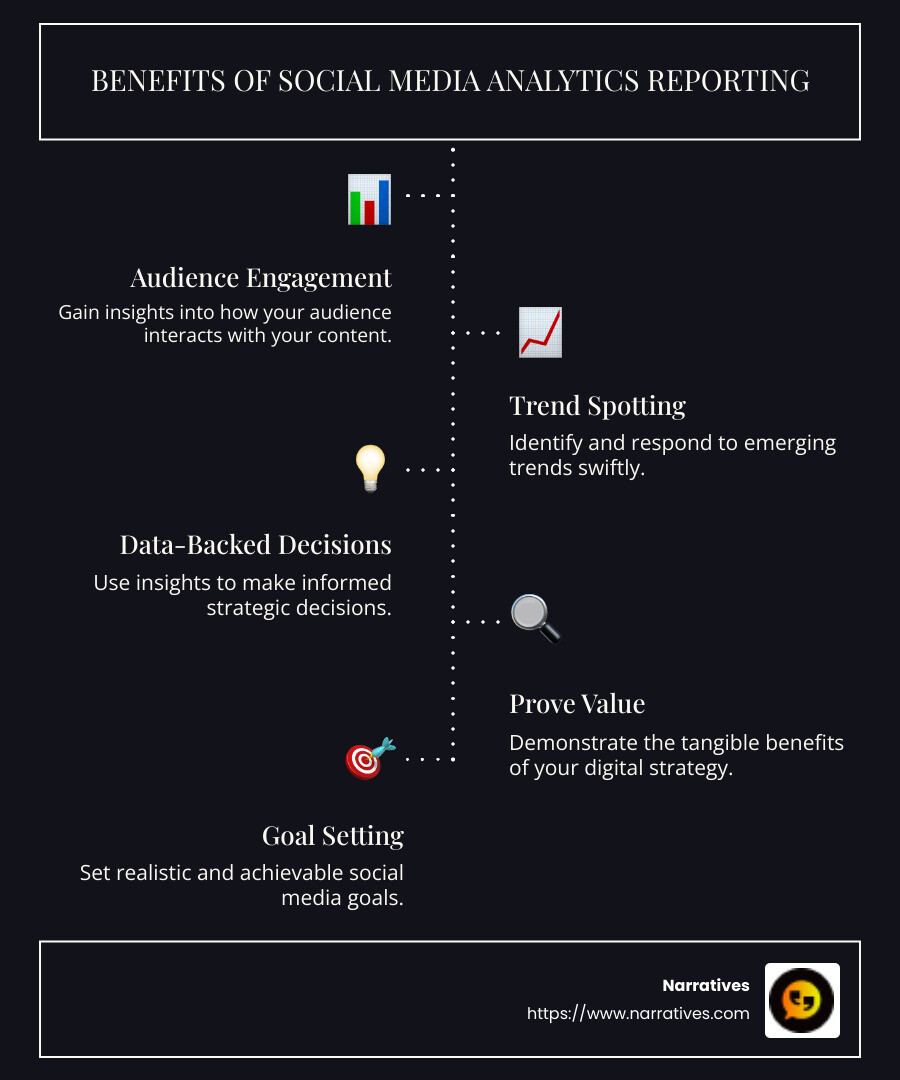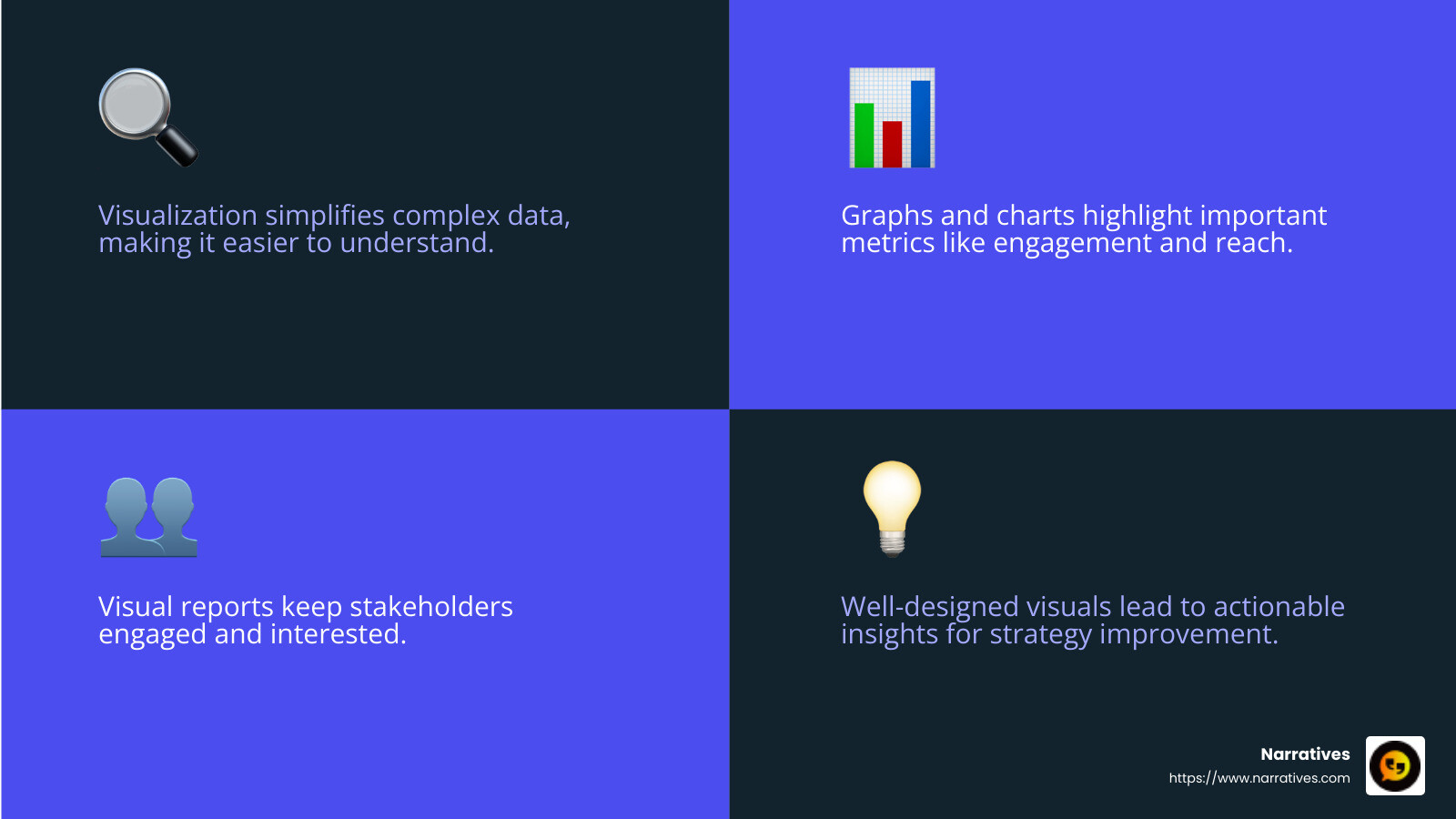Social Media Analytics Reporting: A Step-by-Step Guide

Social media analytics reporting is essential for any organization looking to amplify its mission through impactful digital storytelling. By solveing insights from your social data, you can make informed decisions, adapt your strategy, and achieve your social media goals.
Here's what you'll gain from effective social media analytics reporting:
- A deeper understanding of audience engagement and preferences
- Improved ability to spot trends and adapt swiftly
- Data-backed insights to prove value and set realistic goals
Social media is more than just a platform for posting content; it’s a powerful tool for organizations, especially those in the nonprofit sector, to connect with their audience on a personal level. By diving into the analytics, you can uncover what resonates most with your audience and tailor your storytelling for maximum impact.
You'll find how to harness social media analytics to drive your mission forward. Whether you're looking to increase donations, boost awareness, or grow your community, understanding and applying social media analytics reporting can be a game-changer.

Understanding Social Media Analytics
Social media analytics is the process of collecting and analyzing data from social networks. This data helps organizations understand how their content performs, who their audience is, and how they can improve their strategy.
Definition and Purpose
At its core, social media analytics gives you a clear picture of your online presence. It tracks how well your posts are doing and helps you understand the mood and opinions people have about your brand. By looking at this data, you can see what works and what doesn't, allowing you to make better decisions.
The purpose of social media analytics is to guide your strategy. It helps you spot trends, measure brand sentiment, and understand your audience's value perception. This insight is crucial for setting realistic goals and proving the return on investment (ROI) of your social media efforts.
Tools for Social Media Analytics
There are several tools available to help you gather and analyze social media data. These tools make it easier to create reports that are both informative and easy to understand. Here are some popular options:
Hootsuite: This tool allows you to monitor both paid and organic posts across various networks. It offers basic and advanced analytics, making it suitable for both small teams and large enterprises.
Sprout Social: Known for its user-friendly dashboard, Sprout Social provides detailed performance analysis and competitive insights. It helps you understand your audience and track paid social analytics effectively.
Google Analytics: While not solely a social media tool, Google Analytics can track traffic from social media platforms and provide insights into how users interact with your website.
These tools often include features like trendspotting, which helps you identify upcoming trends before they become mainstream. For example, according to the 2025 Sprout Social Index™, 93% of consumers believe it's important for brands to stay updated with online culture. By using these tools, you can stay ahead of the curve.
Real-World Application
Using social media analytics can transform your strategy. For instance, the @epicurious channel on YouTube shifted its focus from recipe videos to "try" and "guess" videos after analyzing their performance. This pivot led to a significant increase in views, with many videos now reaching millions.
By integrating social media analytics into your strategy, you can improve your storytelling, engage more effectively with your audience, and ultimately drive your mission forward.
In the next section, we'll explore the key metrics you should focus on in your social media analytics reporting to ensure you're on the right track.
Key Metrics for Social Media Analytics Reporting
When diving into social media analytics reporting, it's crucial to focus on the right metrics. These metrics tell you how well your content is doing and help guide your strategy.
Engagement
Engagement measures how much people interact with your content. It includes likes, shares, comments, and more. High engagement means people find your content interesting and valuable.
Why it matters:
- Audience Connection: Engagement shows how well you're connecting with your audience.
- Content Quality: High engagement often indicates high-quality content.
- Feedback Loop: Comments and shares provide direct feedback on what resonates with your audience.
Reach
Reach is the number of unique users who see your content. It's different from impressions, which count every time your content is displayed, even if it's seen by the same person multiple times.
Why it matters:
- Audience Growth: A higher reach means more people are seeing your content, which can lead to more followers.
- Brand Awareness: Greater reach can lead to increased brand awareness and recognition.
- Potential Impact: The more people who see your content, the greater your potential impact.
Conversions
Conversions track how many people take a desired action after interacting with your content. This could be signing up for a newsletter, making a purchase, or any other goal.
Why it matters:
- ROI Measurement: Conversions are a direct measure of your return on investment.
- Goal Achievement: They show how well you're achieving your business goals.
- Strategy Effectiveness: High conversion rates indicate effective strategies and content.
Key Performance Indicators (KPIs)
KPIs are specific metrics that align with your business objectives. They help you measure success and track progress over time.
Common KPIs include:
- Follower Growth: Tracks how your audience is expanding.
- Engagement Rate: Measures the percentage of your audience that interacts with your content.
- Traffic: Monitors the number of visitors to your website from social media.
By focusing on these key metrics, you can create a comprehensive picture of your social media performance. This will guide your strategy and help you make informed decisions.
In the next section, we'll explore how to create a social media analytics report that effectively communicates these insights.
Creating a Social Media Analytics Report
Crafting a social media analytics report involves three key steps: data gathering, visualization, and deriving insights. Let's break these down.
Data Gathering
Before you can analyze anything, you need to gather the right data. This means collecting information from all your social media platforms—think Instagram, Facebook, and Twitter. Each platform offers unique metrics that can help you understand your audience's behavior.
Steps to gather data:
- Identify Your Sources: Determine which social media platforms you will include in your report.
- Use Analytics Tools: Use built-in analytics tools like Instagram Insights or Facebook Page Insights to collect data efficiently.
- Export Data: For a comprehensive view, export your data into spreadsheets or use a tool like Whatagraph to aggregate everything in one place.
Visualization
Data is just numbers until you visualize it. Visualization helps transform raw data into understandable and actionable insights.
Why Visualization Matters:
- Simplifies Complexity: Graphs and charts make complex data easy to digest.
- Highlights Key Metrics: Visuals draw attention to important metrics like engagement and reach.
- Engages Stakeholders: A well-designed report keeps your audience interested and engaged.
Tools for Visualization:
- Whatagraph: Offers customizable dashboards and templates to create visually appealing reports.
- Google Data Studio: A free tool that integrates with various data sources for detailed visual reports.
Insights
Once you have your data visualized, it's time to draw insights. This is where you interpret what the data means for your social media strategy.
How to Derive Insights:
- Identify Trends: Look for patterns in the data, such as spikes in engagement or dips in reach.
- Assess Performance: Compare current metrics to past performance to gauge progress.
- Make Recommendations: Use the insights to suggest actionable steps, like adjusting posting times or focusing on high-engagement content.

By focusing on data gathering, visualization, and insights, you can create a social media analytics report that not only informs but also inspires action. This approach ensures that your social media efforts are aligned with your overall business goals.
In the next section, we'll dig into how social media analytics reporting can be custom for non-profits, emphasizing storytelling and community engagement.
Social Media Analytics Reporting for Non-Profits
When it comes to social media analytics reporting for non-profits, the focus shifts to storytelling, impact measurement, and community engagement. These elements are crucial for showcasing the difference your organization makes and rallying support for your cause.
Storytelling
Storytelling is at the heart of any successful non-profit. It's not just about numbers; it's about the stories behind those numbers. A compelling story can turn data into a narrative that resonates with your audience.
Narratives in Action: Take a cue from Pars Equality Center, which highlights its initiatives by sharing real-life stories of Persian-speaking immigrants. This approach not only informs but also connects emotionally with the audience.
Visual Storytelling: Use images and videos to bring your stories to life. Pictures of community events or interviews with beneficiaries can make your reports more relatable and impactful.
Impact Measurement
Impact measurement is about showing how your efforts are making a tangible difference. It's not enough to say you're doing good; you need to prove it.
Track Key Metrics: Metrics like audience growth, engagement rates, and share of voice can indicate how well your message is spreading and engaging your community.
Use Sentiment Analysis: Tools like sentiment analysis can help gauge how people feel about your cause. Are there more positive mentions than negative ones? This can guide your strategy in addressing community concerns.
Community Engagement
Community engagement is vital for non-profits. It's about building relationships and fostering a sense of belonging among your supporters.
Interactive Content: Encourage your audience to participate by sharing their stories or using specific hashtags. This not only boosts engagement but also builds a community around your cause.
Regular Updates: Keep your community informed with regular updates. Share progress, celebrate milestones, and acknowledge the contributions of volunteers and donors.
By weaving storytelling, impact measurement, and community engagement into your social media analytics reporting, you can create a powerful narrative that not only informs but also inspires action and support. In the next section, we'll explore best practices for effective reporting, focusing on setting SMART goals and understanding your audience.
Best Practices for Effective Reporting
Creating an impactful social media analytics report involves more than just gathering data. It's about setting SMART goals, choosing the right reporting frequency, and knowing your audience.
Setting SMART Goals
SMART goals are a foundation for effective reporting. They ensure your objectives are clear and achievable.
Specific: Clearly define what you want to achieve. For example, instead of saying "increase engagement," specify "boost video shares by 20%."
Measurable: Use numbers to track progress. Metrics like clicks, shares, and comments are easy to measure and provide tangible evidence of success.
Achievable: Ensure you have the resources to meet your goals. If your budget or team is limited, aim for realistic targets.
Realistic: Set goals that are challenging yet attainable. Avoid promising to triple your followers in a month if it's not feasible.
Time-sensitive: Assign a deadline. This could be weekly, monthly, or quarterly, depending on your strategy.
Choosing the Right Reporting Frequency
The frequency of your reports can influence their effectiveness. Different time frames serve different purposes.
Daily Reports: Useful for monitoring immediate issues like brand mentions or customer complaints.
Weekly Reports: Ideal for spotting trends and making quick adjustments.
Monthly Reports: Provide a broader view of metrics and are great for presenting to managers.
Quarterly Reports: Offer insights into long-term trends and overall performance.
Each frequency has its place, but the key is to choose one that aligns with your goals and audience needs.
Understanding Your Audience
Tailoring your report to your audience ensures it resonates with them.
Marketing Teams: Focus on campaign-specific data and engagement metrics. They want to know what's working and why.
Leadership: Highlight conversions and ROI. These stakeholders are interested in the financial impact of your efforts.
General Audience: Use simple language and visuals. Not everyone is familiar with industry jargon, so make your reports accessible.
By setting SMART goals, choosing the right frequency, and understanding your audience, your social media analytics reporting can be both effective and impactful. Next, we'll dive into frequently asked questions about social media analytics reporting to address common queries and concerns.
Frequently Asked Questions about Social Media Analytics Reporting
What is social media analytics?
Social media analytics is the process of collecting and analyzing data from social media platforms to understand and optimize your digital marketing efforts. Think of it as a magnifying glass that helps you see how your posts and campaigns are performing.
Why is it important? It helps you identify what content resonates with your audience, spot trends, and make data-driven decisions to improve your strategy.
What tools are used for social media analytics?
To make sense of the vast amount of data on social media, you need the right tools. Here are some common tools that can help:
Hootsuite Analytics: This tool provides a comprehensive dashboard to monitor both paid and organic social media activities across various platforms. It's great for creating visually appealing reports that are easy to share with your team.
Google Analytics: While not exclusively for social media, it can be integrated to track how social media traffic impacts your website, offering insights into conversions and user behavior.
Whatagraph: Known for its user-friendly interface, Whatagraph allows you to automate report creation and customize data visualization, making it easier to digest complex data.
These tools simplify the process of social media analytics reporting, allowing you to focus on what really matters—engaging your audience and achieving your goals.
By understanding what social media analytics is and utilizing the right tools, you can turn data into actionable insights that drive success. For more on how we at Narratives can help your non-profit with impactful storytelling, visit our media services page.


